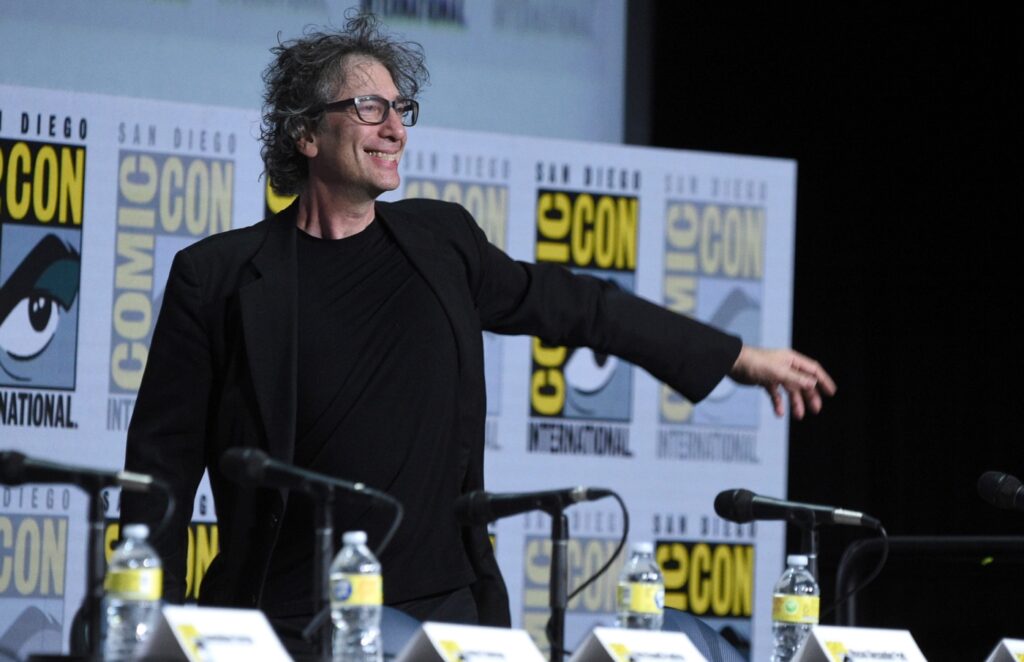
It’s been more than 30 years since the first issue of “The Sandman” debuted in 1989 from DC Comics. The book catapulted writer Neil Gaiman to fame for his intricate layers of storytelling that didn’t hesitate to dive into the metaphysical and metaphorical.
At a press roundtable at Comic-Con International on Saturday, July 23, Gaiman and Allan Heinberg, co-executive producers, along with the members of the show’s cast discussed how the series broke ground in terms of gender identity and race, and defied adaptation to the screen for decades – until now.
“It just felt like [we] were all talking the same language from the beginning,” Neil Gaiman said of making the TV series premiering Aug. 5 on Netflix, starring Tom Sturridge.
Previous screen adaptations failed to come to fruition, largely because the universe of ‘The Sandman’ seemed almost impossible to bring to life in the length of a film.
“You can’t just stage it and film it panel-for-panel…because it becomes like cosplay,” said Heinberg. Having Gaiman on board helped bring the novel to life on the screen with the “heart” of the work intact, he said. “I was lucky because I could call Neil and we would work out every step.”
The comic book tells the story of Dream/Morpheus/The Sandman, one of The Endless – godlike personifications of the human experience who each rule over their own kingdom. At the beginning of the series, Dream has been in prison for a century. His absence has led to human suffering and the decay of order; now that he’s escaped imprisonment, he must try to rebuild his domain.
When it first debuted, the graphic novel skipped the step of assigning races and genders to some of its characters – they were beyond definition. While that wasn’t considered “political” in the late ‘80s, Gaiman said, today some people feel, with the TV series casting a diverse array of actors to play beloved characters, “that we’ve gone woke.”
But representing different genders and races was a part of the storytelling from the beginning, Gaiman said. “I don’t know if we were ahead of our time…it was just in there, baked into the foundations.”
Much of it was subtextual, he explained – while characters such as Dream’s sibling Death may not have been depicted in art panels as Black, context clues should have been a dead giveaway.
Kirby Howell Baptiste, who was cast to play Death, read the series a decade ago after reading “American Gods,” one of Gaiman’s other works that’s been adapted into a TV series on Amazon.
“I think that it’s important to recognize that Neil is someone who’s always been pushing these boundaries,” Baptiste said. “Neil was doing groundbreaking things when it came to gender and showing people who have traditionally been in certain roles outside of those roles.”
One example is Desire, one of Dream’s siblings, who in the series does not have a fixed gender.
“We didn’t use the singular ‘they’ because that wasn’t in use [at the time],” Gaiman said. “But we had a dozen different pronoun configurations, all of which were indicating that Desire had a multitude of genders, and transcended gender.”
Related Articles
Comic-Con 2022: Scott Shaw says there’s no place like SDCC and he should know. He helped start it.
See into the Spider-verse with a look at Marvel’s Spider-Man exhibition in the Comic-Con Museum
Comic-Con 2022: The ’80s are, like, totally having a rad comeback in San Diego
Comic-Con 2022: ‘Love and Rockets’ creators Gilbert and Jaime Hernandez celebrate 40 years of comics
Comic-Con 2022: Women in Comics Collective marks 10 years working for better representation
In the Netflix adaptation, Desire is played by non-binary actor Mason Alexander Park. “It was so ahead of its time and so in line with the conversation we’re having today,” Park said Saturday. And when it came to being on set, “there was something so unbelievably moving about the scale and the scope of the world they were building. I never thought it would be this magnificent.”
“It’s not like we’re injecting anything new into these stories – we’re just showing a reflection of people who exist in the world,” said Vanesu Samunyai. She plays Rose Walker, a mortal girl who has an important role in Dream’s mission to mend his kingdom. “As a Black girl, imagining myself in different stories has been so hard – it’s really important to see more diversity so you can see yourself as the main character in your own story.”
At long last, Gaiman said, the Netflix series is an accurate representation of his work, 30-plus years after its creation.
“This is Sandman,” Gaiman said, “and it’s the same.”
